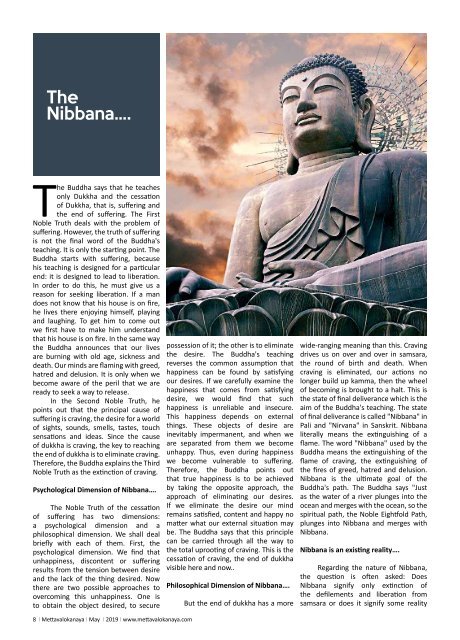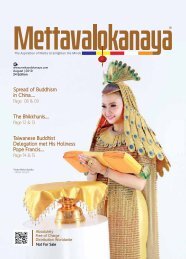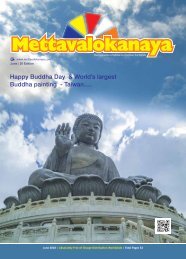Mettavalokanaya_International_Buddhist_Magazine_May_2019
“Mettavalokanaya” Sri Lanka’s leading & Most popular International Monthly Buddhist Magazine has been successfully distributed to 40 countries including all districts across Sri Lanka.
“Mettavalokanaya” Sri Lanka’s leading & Most popular International Monthly Buddhist Magazine has been successfully distributed to 40 countries including all districts across Sri Lanka.
Create successful ePaper yourself
Turn your PDF publications into a flip-book with our unique Google optimized e-Paper software.
The<br />
Nibbana….<br />
The Buddha says that he teaches<br />
only Dukkha and the cessation<br />
of Dukkha, that is, suffering and<br />
the end of suffering. The First<br />
Noble Truth deals with the problem of<br />
suffering. However, the truth of suffering<br />
is not the final word of the Buddha's<br />
teaching. It is only the starting point. The<br />
Buddha starts with suffering, because<br />
his teaching is designed for a particular<br />
end: it is designed to lead to liberation.<br />
In order to do this, he must give us a<br />
reason for seeking liberation. If a man<br />
does not know that his house is on fire,<br />
he lives there enjoying himself, playing<br />
and laughing. To get him to come out<br />
we first have to make him understand<br />
that his house is on fire. In the same way<br />
the Buddha announces that our lives<br />
are burning with old age, sickness and<br />
death. Our minds are flaming with greed,<br />
hatred and delusion. It is only when we<br />
become aware of the peril that we are<br />
ready to seek a way to release.<br />
In the Second Noble Truth, he<br />
points out that the principal cause of<br />
suffering is craving, the desire for a world<br />
of sights, sounds, smells, tastes, touch<br />
sensations and ideas. Since the cause<br />
of dukkha is craving, the key to reaching<br />
the end of dukkha is to eliminate craving.<br />
Therefore, the Buddha explains the Third<br />
Noble Truth as the extinction of craving.<br />
Psychological Dimension of Nibbana….<br />
The Noble Truth of the cessation<br />
of suffering has two dimensions:<br />
a psychological dimension and a<br />
philosophical dimension. We shall deal<br />
briefly with each of them. First, the<br />
psychological dimension. We find that<br />
unhappiness, discontent or suffering<br />
results from the tension between desire<br />
and the lack of the thing desired. Now<br />
there are two possible approaches to<br />
overcoming this unhappiness. One is<br />
to obtain the object desired, to secure<br />
possession of it; the other is to eliminate<br />
the desire. The Buddha's teaching<br />
reverses the common assumption that<br />
happiness can be found by satisfying<br />
our desires. If we carefully examine the<br />
happiness that comes from satisfying<br />
desire, we would find that such<br />
happiness is unreliable and insecure.<br />
This happiness depends on external<br />
things. These objects of desire are<br />
inevitably impermanent, and when we<br />
are separated from them we become<br />
unhappy. Thus, even during happiness<br />
we become vulnerable to suffering.<br />
Therefore, the Buddha points out<br />
that true happiness is to be achieved<br />
by taking the opposite approach, the<br />
approach of eliminating our desires.<br />
If we eliminate the desire our mind<br />
remains satisfied, content and happy no<br />
matter what our external situation may<br />
be. The Buddha says that this principle<br />
can be carried through all the way to<br />
the total uprooting of craving. This is the<br />
cessation of craving, the end of dukkha<br />
visible here and now..<br />
Philosophical Dimension of Nibbana….<br />
But the end of dukkha has a more<br />
wide-ranging meaning than this. Craving<br />
drives us on over and over in samsara,<br />
the round of birth and death. When<br />
craving is eliminated, our actions no<br />
longer build up kamma, then the wheel<br />
of becoming is brought to a halt. This is<br />
the state of final deliverance which is the<br />
aim of the Buddha's teaching. The state<br />
of final deliverance is called "Nibbana" in<br />
Pali and "Nirvana" in Sanskrit. Nibbana<br />
literally means the extinguishing of a<br />
flame. The word "Nibbana" used by the<br />
Buddha means the extinguishing of the<br />
flame of craving, the extinguishing of<br />
the fires of greed, hatred and delusion.<br />
Nibbana is the ultimate goal of the<br />
Buddha's path. The Buddha says "Just<br />
as the water of a river plunges into the<br />
ocean and merges with the ocean, so the<br />
spiritual path, the Noble Eightfold Path,<br />
plunges into Nibbana and merges with<br />
Nibbana.<br />
Nibbana is an existing reality….<br />
Regarding the nature of Nibbana,<br />
the question is often asked: Does<br />
Nibbana signify only extinction of<br />
the defilements and liberation from<br />
samsara or does it signify some reality<br />
existing in itself? Nibbana is not only the<br />
destruction of defilements and the end<br />
of samsara but a reality transcendent to<br />
the entire world of mundane experience,<br />
a reality transcendent to all the realms<br />
of phenomenal existence. The Buddha<br />
refers to Nibbana as a 'dhamma'. For<br />
example, he says "of all dhammas,<br />
conditioned or unconditioned, the<br />
most excellent dhamma, the supreme<br />
dhamma is, Nibbana". 'Dhamma'<br />
signifies actual realities, the existing<br />
realities as opposed to conceptual<br />
things. Dhammas are of two types,<br />
conditioned and unconditioned. A<br />
conditioned dhamma is an actuality<br />
which has come into being through<br />
causes or conditions, something which<br />
arises through the workings of various<br />
conditions. The conditioned dhammas<br />
are the five aggregates: material form,<br />
feeling, perception, mental formations<br />
and consciousness. The conditioned<br />
dhammas do not remain static. They go<br />
through a ceaseless process of becoming.<br />
They arise, undergo transformation and<br />
fall away due to its conditionality.<br />
However, the unconditioned<br />
dhamma is not produced by causes<br />
and conditions. It has the opposite<br />
characteristics from the conditioned:<br />
it has no arising, no falling away and<br />
it undergoes no transformation.<br />
Nevertheless, it is an actuality, and<br />
the Buddha refers to Nibbana as an<br />
unconditioned Dhamma. The Buddha<br />
also refers to Nibbana as an 'ayatana'.<br />
This means realm, plane or sphere. It is a<br />
sphere where there is nothing at all that<br />
corresponds to our mundane experience,<br />
and therefore it has to be described by<br />
way of negations as the negation of all<br />
the limited and determinate qualities<br />
of conditioned things. The Buddha<br />
also refers to Nibbana as a 'dhatu,' an<br />
element, the 'deathless element' (amatadhatu).<br />
He compares the element of<br />
Nibbana to an ocean. He says that just<br />
as the great ocean remains at the same<br />
level no matter how much water pours<br />
into it from the rivers, without increase<br />
or decrease, so the Nibbana element<br />
remains the same, no matter whether<br />
many or few people attain Nibbana. He<br />
The world-famous American<br />
Author, New York, USA<br />
Most Venerable<br />
Bhikkhu Bodhi<br />
USA<br />
also speaks of Nibbana as something<br />
that can be experienced by the body, an<br />
experience that is so vivid, so powerful,<br />
that it can be described as "touching the<br />
deathless element with one's own body."<br />
The Buddha also refers to Nibbana<br />
as a 'state' (pada), as 'amatapada' - the<br />
deathless state - or ‘accutapada’, the<br />
imperishable state. Another word used<br />
by the Buddha to refer to Nibbana is<br />
'sacca', which means 'truth', an existing<br />
reality. This refers to Nibbana as the<br />
truth, a reality that the Noble Ones have<br />
known through direct experience. So,<br />
all these terms, considered as a whole,<br />
clearly establish that Nibbana is an actual<br />
reality and not the mere destruction of<br />
defilements or the cessation of existence.<br />
Nibbana is unconditioned, without any<br />
origination and is timeless.<br />
The Buddha speaks of Nibbana<br />
primarily by way of terms negating<br />
suffering: as cessation of suffering,<br />
cessation of old age and death, the<br />
unafflicted, the unoppressed, the<br />
sorrowless state, and so forth. It is<br />
also described as the negation of the<br />
defilements, the mental factors that keep<br />
us in bondage. So Nibbana is described<br />
as the same as the destruction of greed,<br />
hatred and delusion. It is also called<br />
dispassion (viraga), the removal of thirst,<br />
the crushing of pride, the uprooting of<br />
"Nibbana element<br />
without a residue<br />
remaining"….<br />
conceit, the extinction of vanity.<br />
The purpose behind the Buddha's<br />
negative terminology is to show that<br />
Nibbana is utterly transcendental<br />
and beyond all conditioned things; to<br />
show that Nibbana is desirable, that<br />
it is the end of all suffering, and to<br />
show that Nibbana is to be attained<br />
by eliminating defilements. The use of<br />
negative terminology should not be<br />
misunderstood to mean that Nibbana<br />
is mere annihilation, a pure negative<br />
attainment. To correct this one sided<br />
view, the Buddha also describes Nibbana<br />
in positive terms. He refers to Nibbana<br />
as the supreme happiness, perfect bliss,<br />
peace, serenity, liberation, freedom. He<br />
calls Nibbana 'the island', an island upon<br />
which beings can land, which is free<br />
from suffering. For those beings swept<br />
away helplessly towards the ocean of old<br />
age and death, it is a place of safety and<br />
security.<br />
The passing away of an arahant is<br />
the final and complete passing out from<br />
conditioned existence. It does not lead<br />
to a new birth. In his own experience,<br />
the arahant sees only the cessation of<br />
a process, not the death of a self. The<br />
experience for him is without subjective<br />
significance, without reference to 'me’<br />
or ‘mine'. At this stage the residue of the<br />
five aggregates comes to an end.<br />
8 l <strong>Mettavalokanaya</strong> l <strong>May</strong> l <strong>2019</strong> l www.mettavalokanaya.com www.mettavalokanaya.com l <strong>2019</strong> l <strong>May</strong> l <strong>Mettavalokanaya</strong> l 9
















